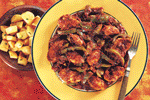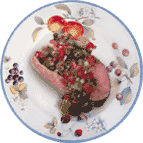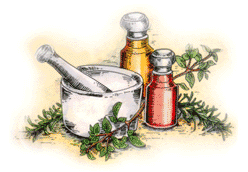|
- Baker's Yeast
- "Khameer" in Urdu -
also called "Yeast", is the common name for the strains of yeast used as a leavening agent in baking bread and bakery products, where it converts the fermentable sugars present in the dough into carbon dioxide and ethanol.
- Banana
- "Kaila" in Urdu -
An elongated curved fruit, which grows in bunches, and has a sweet creamy flesh and a smooth yellow skin; The tropical treelike plant which bears clusters of bananas.
- Baking Powder
- "Pakanay Ka Soda" in Urdu -
A dry chemical leavening agent used to increase the volume and lighten the texture of baked goods.
- Barley
- "Jau" in Urdu -
A cereal grain, has a mild, starchy flavor and a slightly chewy texture. Pearl barley, the most popular form used for cooking, has the outer hull removed and has been polished or "pearled." It is sold in regular and quick-cooking forms.
- Basil
- "Tulsi" in Urdu -
\Common name of an aromatic, herbaceous plant, Ocimum basilicum, of the mint family Lamiaceae. This species, often referred to as sweet basil, is widely cultivated for its edible leaves. Basil is originally native to Iran, India and other tropical regions of Asia, having been cultivated there for more than 5,000 years.
- Bay Leaf
- "Tezz Patta" in Urdu -
Also called Cassia Leaf, fresh or dried bay leaves are used in cooking for their distinctive flavor and fragrance. The leaves are often used to flavor soups, stews, braises and pÔtÚs in Mediterranean cuisine. The fresh leaves are very mild and do not develop their full flavor until several weeks after picking and drying.
- Beef
- "Gaen Ka Gosht" in Urdu -
Beef is the culinary name for meat from bovines, especially domestic cattle (cows). Beef is one of the principal meats used in the cuisine of Australia, Argentina, Europe and America, and is also important in Africa, East Asia, and Southeast Asia.
- Beef Broth
- "Gosht Ki Yakhni" or "Gosht Ka Shorba" in Urdu -
also called "Beef Stock" is a liquid in which beef bones and meat are simmered to make a juice. It is used as a basis for other edible liquids such as soup, gravy, or sauce. It can be eaten alone or with garnish.
- Beef Stock
- "Gosht Ki Yakhni" or "Gosht Ka Shorba" in Urdu -
also called "Beef Broth" is a liquid in which beef bones and meat are simmered to make a juice. It is used as a basis for other edible liquids such as soup, gravy, or sauce. It can be eaten alone or with garnish.
- Beet Root
- "Chukandar" in Urdu -
A plant in the amaranth family. It is best known in its numerous cultivated varieties, the most well known of which is probably the red root vegetable known as the beetroot or garden beet.
- Bell Pepper
- "Shimla Mirch" in Urdu -
Also called, Sweet Pepper, the Bell Pepper is a cultivar group of the species Capsicum annuum (chili pepper). Cultivars of the plant produce fruits in different colors, including red, yellow and orange. The fruit is also frequently consumed in its unripe form, when the fruit is still green.
- Bengal Gram
- "Chana Dal" in Urdu -
One of the most important pulses in Pakistan and India. It is consumed in the form of whole dried seeds and in the form of dhal, prepared by splitting the seeds in a mill and separating the husk. Seeds are angular with pointed beak and small hilum. All parts of the plant are covered with glandular hairs.
- Bengal Gram Flour
- "Besan" in Urdu -
A flour made from ground chickpeas, a legume otherwise known as chana dal. It is also known as chickpea flour, garbanzo flour, or besan . Used in many countries, it is a staple ingredient in Indian, Pakistani and Bangladeshi cuisines, and in the form of a paste with water or yoghurt, a popular facial exfoliant in the Indian Subcontinent. Moreover, when mixed with an equal proportion of water, can be used as an egg-replacer in vegan cooking.
- Betal Leaf
- "Paan" in Urdu -
Pakistani and South East Asian tradition of chewing betel leaf (Piper betle) with areca nut and slaked lime paste. There are many regional and local variations. It is a Piper betle leave chew, chewed as a palate cleanser, a breath freshener, and for digestive purposes as well.
- Betal Nut
- "Chaaliya" in Urdu -
The Betal nut is another name for the Areca Nut, the seed of the Areca palm (Areca catechu), which grows in much of the tropical Pacific, Asia, and parts of east Africa. It is commonly referred to as "betel nut" as it is often chewed wrapped in betel leaves.
- Bitter Gourd
- "Karela" in Urdu -
Also known as bitter Melon, the bitter gourd is a tropical and subtropical vine of the family Cucurbitaceae, widely grown for edible fruit, which is among the most bitter of all fruits. It has excellent medicinal virtues. It is antidotal, antipyretic tonic, appetizing, stomachic, antibilious and laxative. The bitter gourd is also used in native medicines of Asia and Africa.
- Bitter Melon
- "Karela" in Urdu -
Also known as bitter gourd, the bitter melon is a tropical and subtropical vine of the family Cucurbitaceae, widely grown for edible fruit, which is among the most bitter of all fruits. It has excellent medicinal virtues. It is antidotal, antipyretic tonic, appetizing, stomachic, antibilious and laxative. The bitter gourd is also used in native medicines of Asia and Africa.
- Black Cardamom
- "Bari Ilaichi" or "Kaali Ilaichi" in Urdu -
Black cardamom also known as brown cardamom is a plant in the family Zingiberaceae. Its seed pods have a strong camphor-like flavor, with a smoky character derived from the method of drying.
- Black Eyed Beans
- "Lobiya" in Urdu -
Also called, black-eyed peas, Chawalie, etc. in various languages in India, is a subspecies of the cowpea, grown around the world for its medium-sized edible bean. The bean mutates easily, giving rise to a number of varieties.
- Black Gram
- "Kaala Chana" in Urdu -
Black gram is one of the most highly prized pulses of Pakistan and India. It is an erect, sub erect or trailing, densely hairy annual herb. The tap root produces a branched root system with smooth, rounded nodules. The pods are narrow, cylindrical and up to 6cms. long. It is the most nutritious of all pulses.
- Black Pepper
- "Kaali Mirch" or "Seeya Mirch" in Urdu -
A powder made from seeds (peppercorns) of the plant Piper Nigrum which is commonly used as a spice. Usually but not always used ground or crushed. Pepper Corns also come in forms that produce white pepper and several other varieties.
- Bottle Gourd
- "Lowki" in Urdu -
A vine grown for its fruit, which can either be harvested young and used as a vegetable or harvested mature. The fresh fruit has a light green smooth skin and a white flesh. However the rounder varieties are called Calabash gourds whereas the longer and slimmer kinds are usually well known as bottle gourds.
- Brain
- "Maghaz" or "Bheja" in Urdu -
Cow or Sheep Brain is prepared with spices and eaten by Pakistanis. Brain Masala is a common and delicious dish made in Pakistan and Pakistani Restaurants around the world.
- Bread
- "Double Roti" in Urdu -
A food made from dough of flour or meal and usually raised with yeast or baking powder and then baked.
- Bread Crumbs
- "Double Roti Ka Choora" in Urdu -
Small particles of dry bread, which are used for breading or crumbing foods, topping casseroles, stuffing poultry, thickening stews, and adding inexpensive bulk to meatloaves and similar foods.
- Brinjal
- "Baingan" in Urdu -
Also called Eggplant or Aubergine, Brinjal comes from a plant of the family Solanaceae (also known as the nightshades) and genus Solanum. It bears a fruit of the same name, commonly used as a vegetable in cooking. As a nightshade, it is closely related to the tomato and potato and is native to Pakistan, Nepal, India, Bangladesh, and Sri Lanka.
- Broad Beans
- "Saim Ki Phali" in Urdu -
Broad bean is also known as horse bean, windsor bean, english bean, tick bean, fava bean, field bean, and pigeon bean. Broad beans are sometimes classified into subspecies according to varieties and their uses in various countries. Thus, subspecies faba var. minor is the beck, tick, or pigeon bean, greatly used for human consumption in the Arabic world, but also used for animal forage, like the horse bean (var. equina) specifically fed to horses. The broad bean proper, also known as Windsor or straight bean, is var. major. Indian varieties, generally dried and eaten as pulses, are classified as subspecies paucyuga.
- Broken Wheat
- "Dalia" in Urdu -
Broken wheat is also known as Bulgar wheat or cracked wheat. It is made by milling wheat grains coarsely. Wheat is cleaned and husked and then processed to the required size. It is highly nutritious as it does not undergo refining. When cooked, broken wheat has a very hearty, warm aroma and a grainy, delightful taste. It is slightly nutty and chewy.
- Broth
- "Yakhni" in Urdu -
also called "Soup" or "Stock", is a liquid in which meat and vegetables are simmered; used as a basis for soups or sauces.
- Brown Sugar
- "Gurh" in Urdu -
Brown sugar is a sucrose sugar product with a distinctive brown color due to the presence of molasses. It is either an unrefined or partially refined soft sugar consisting of sugar crystals with some residual molasses content, or it is produced by the addition of molasses to refined white sugar.
- Butter
- "Makhan" in Urdu -
Butter is a dairy product made by churning fresh or fermented cream or milk. It is generally used as a spread and a condiment, as well as in cooking applications such as baking, sauce making, and frying. Butter consists of butterfat, water and milk proteins.
- Buttermilk
- "Chaach" in Urdu -
Buttermilk is the result that remains after the butter is separated from a cream. It is residue from making butter from sour raw milk; or pasteurized milk curdled by adding a culture.
|


























|































































